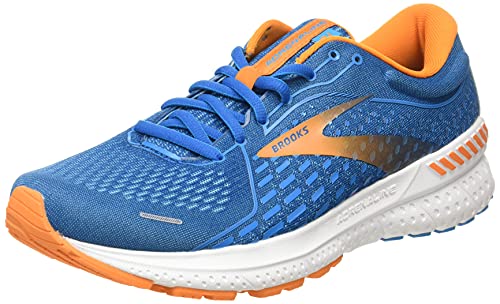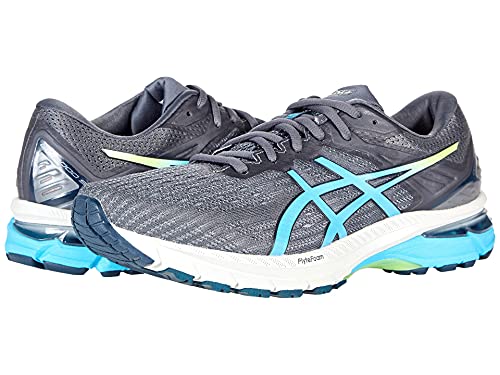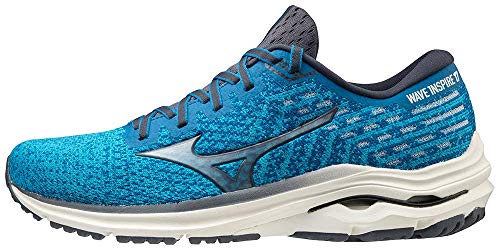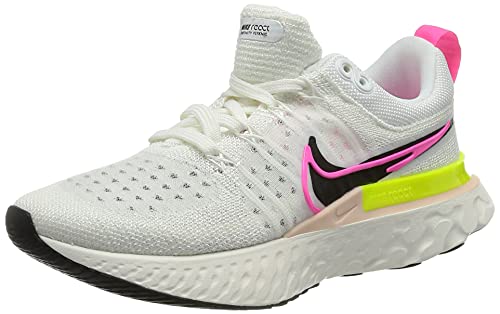Overpronation. The mere name makes it seem as if this gait characteristic is a debilitating medical condition that’s going to rob you of your ability to run. The truth is, every runner pronates to some degree, and overpronation is nowhere near as scary as it sounds, especially when you’re wearing the best running shoes for overpronation.
When we walk or run, our feet naturally roll slightly inward as we take a step or stride. This action is called pronation. For many runners, they pronate aggressively, which causes the foot to roll too far inward with each stride. This action is called overpronation.
Overpronation puts additional pressure and stress on your feet, and over time it can result in foot pain, shin splints, and even back or hip issues. Fortunately, there are plenty of quality shoes that offer additional stability so runners who overpronate can run comfortably without risk of injury.
In the 70s and 80s, running shoe manufacturers designed shoes with aggressive medial posts that aimed to “correct” overpronation by preventing the foot from rotating inwards as aggressively. In practice, all these stability shoes did was make it more uncomfortable for overpronators to run without doing much to improve their gait.
Today, the oversized medial post has given way to a more neutral shoe design, and manufacturers are focusing not on correcting overpronation, but on providing shoes that provide the comfort and support overpronators need to run comfortably while avoiding injuries.
Read on, as we take a closer look at the best overpronation running shoes, and take a deep dive into what you’ll need to know to select the ideal pair of shoes for your running style.

The New Balance 860 has long been a favorite of overpronators, and this latest version adds numerous performance and comfort upgrades that help take the shoe to the next level.
The design harkens back to the old days when medial posts were all the rage in motion-control footwear. The 860 still includes a medial post to help limit pronation, while the Fresh Foam X midsole dramatically improves comfort while providing a smoother ride across all surfaces and responding more quickly than past versions of the 860.
Thanks to the Fresh Foam midsole, the once bulky 860 is now much more streamlined. These shoes are still on the heavy side, weighing in just north of 12 ounces, but they’re still nearly an ounce lighter than the previous version of the 860.
The 860v11 bridges the gap for runners who like the support and stability that medial posting provides, but are hoping for a modern shoe with a more neutral look.

The Brooks Adrenaline GTS is now in its 21st edition, which is truly an accomplishment that few running shoes ever achieve. After a few iterations, most manufacturers scrap a shoe and embrace new designs. The Brooks Adrenaline is a classic shoe that manages to improve with each redesign, and the Adrenaline GTS 21 is the crown jewel so far.
This model replaces the medial posts of yesteryear with adaptive guide rails that only engage when your foot needs additional support. The guide rails act almost like bumpers at a bowling alley, and you can feel them engage as you run, providing the support and stability that overpronators need.
The upper is a generous width, and you never feel like your foot is constrained as you run. The midsole is exceptionally durable, and it’s built to stand up to hundreds of miles, and they’re available in nine colorways to suit the style of every runner.

Now in its 27th edition, the Asics Gel Kayano continues to be a favorite of runners who need a stability-minded shoe.
The Kayano boasts Asics’ DuoMax dual-density midsole support system which runs from the heel to the arch of the foot, similar to a medial post. The Trusstic system on the arch side of the outsole provides additional stability, and the rear of the shoe is quite stiff and supportive. Rounding out the support features is the MetaClutch exoskeleton heel system, which locks your heel in place as you run for added support.
The upper offers a tailored fit that feels a bit tight and uncomfortable during the first few runs. Over time, they do open up a bit and become more comfortable.

This shoe features Hoka One One’s Meta-Rocker design which offers a smooth transition throughout your stride. It also features a J-Frame, which delivers enhanced support along the medial side and wraps around the heel to lock it in place and provide support. The heel is extended to help offer a smoother ride, and the upper is generously sized, making this an ideal runner for people with wider feet.
An ideal option for runners who need a stability shoe, but would prefer not to feel like they’re running in work boots. The Arahi 5 is one of the lightest stability shoes on the market, and it manages to shed weight without sacrificing support.

The GT-2000 is one of the oldest and most popular stability trainers ever, and the latest iteration delivers impressive stability, comfort, and performance features.
The GT-2000 offers the DuoMax and Trusstic systems that are standard issue with all Asics’ stability shoes, including the Gel Kayano. The heel features a clutching system, but it’s not quite as supportive as the Exoskeleton system found in Asics’ pricier stability shoes. The midsole is also a bit more stiff and unforgiving compared to the Gel Kayano.
The upper breathes exceptionally well, and it’s soft while still delivering impressive stability and support. The toe box is a bit narrow though, which may be a concern for people looking for wide toe box running shoes.

Mizuno’s mid-tier stability shoe, the Inspire, is back in its 17th iteration, and it delivers strong support and a bold new look.
The Wave Inspire is characterized by Mizuno’s signature Wave Plate, which is similar to the medial posts of yesteryear. The Wave Plate runs from the heel to the arch on the medial side, and there are also miniature Wave Plates throughout designed to control flex and support in key areas.
The Wave Inspire delivers impressive stability, but that comes at the sacrifice of comfort. While the support is always there, the unforgiving ride of the Wave Inspire makes them a tough sell for longer runs.

The latest Saucony Guide is a solid performer that’s worth a closer look for anyone who needs a moderate level of overpronation support.
The 14th version of the Guide offers a newly redesigned FORMFIT upper that’s more sleek and streamlined than past iterations. The upper is quite comfortable for the most part, and it conforms well to the foot without feeling too tight anywhere. A classic medial post provides additional stability and delivers a modest rocker effect, which feels comfortable and natural.
If there’s any knock on this shoe, it’s that the upper seems a bit thicker than it needs to be. While these shoes are no heavier than other stability trainers, they aren’t light by any stretch, and a thinner upper would allow them to save a bit of weight.

The 10th Anniversary Asics GT-1000 is one of the brand’s sportiest offerings, and it brings some high-end features to go with its trendy looks.
This shoe offers many of the same technologies as Asics other support runners, including the DuoMax midsole and FlyteFoam. It doesn’t offer quite as much stability-enhancing technology as the pricier Asics support shoes, but that makes it ideal for runners with light to moderate overpronation.
GEL technology in the heel and forefoot delivers bounce and cushioning, which is balanced out by the stiffer midsole design. The GT-1000 offers Asics’ legendary AHAR outsole, which wears incredibly well and will deliver hundreds of miles of use.


Compared to the original Infinity Run, this new version offers better heel and midfoot lockdown. But, if you’re looking for support for severe overpronation, you’ll find the Infinity Run 2 to be lacking. If you have mild or moderate overpronation, you should find this shoe to be an ideal match for you.
The upper is comfortable and well-padded, and with the superior cushioning, this is a runner you can put some serious miles on.

The midsole guide rail system delivers all the stiffness and stability you could ask for, while DNA LOFT cushioning offers an exceptionally plush feel that’s rivaled only by the Brooks Glycerin. The knit upper provides an ideal fit for a variety of foot types, and it achieves a streamlined look despite being heavily cushioned.
If you need enhanced stability and support and aren’t looking to compromise on comfort, the Transcend 7 is one to take a closer look at.
Offering the best of both worlds between cushioning and stability, the Brooks Transcend 7 is an ideal choice for runners with moderate to severe overpronation.

The Shift features a large TPU heel counter that keeps you locked in and supported without making you feel like your heel is in a vise. The midsole is dual-density and leverages PWRRUN and PWRRUN+ technologies to deliver tons of cushioning. Even with the cloud-like cushioning, the Shift still provides impressive energy return thanks to the SpeedRoll midsole.
The SpeedRoll system functions as a rocking chair, propelling you into your next step as you run. If you have excellent form, this is a shoe that rewards you. Meanwhile, if you tend to shuffle your feet when you run, you may feel as if you’re fighting against the shoe.
An ideal recovery shoe, the Endorphin Shift from Saucony offers plenty of support while providing extra cushioning to keep you running with less discomfort.

This runner features a padded heel cup, which keeps your foot secure without feeling like it’s “locked in.” A guide rail system in the midfoot helps provide additional stability, providing gentle overpronation correction along with the additional support that overpronators need in a shoe. These shoes also feature a contoured insole that lends further stability and plenty of comfort.
The Provision 5 also features Altra’s Natural Ride System, which is a series of design features aimed at improving the natural mechanics of your foot, which helps to reinforce proper pronation while providing a more natural feel underfoot.
An ideal recovery shoe, the Endorphin Shift from Saucony offers plenty of support while providing extra cushioning to keep you running with less discomfort.

If you’re an overpronator, here are the characteristics you’ll want to look for in your next pair of running shoes.
Guide rails are used in many of the most popular overpronation shoes, and they provide adaptive support to help correct overpronation. Unlike medial posting, guide rails provide additional support when and where it’s needed, so they can adapt to the needs of different runners and pronation levels.
Beyond features like guide rails or medial posts, you’ll also want a shoe that offers a stiff heel counter to effectively lock your heel in place as you run. Without heel support, you’ll continue to overpronate as you run. Look for a shoe that feels like it’s giving your heel a gentle hug as you move.
Stability-enhancing features come at a cost, and that cost is additional weight. While a typical runner weighs around eight ounces, most running shoes for overpronation are in the 10-11 ounce range, while the most supportive offerings can run north of 12-ounces per shoe.
Added weight is a given, but that doesn’t mean you can’t still search for the lightest shoe that still offers the stability and support your gait requires.
A firm midsole is another stability-enhancing feature to look for in the best running shoes for overpronation. Additional firmness in the midsole area lends extra support, which is critical for overpronators.
Many manufacturers employ dual-density foams in their midsoles, which offer enhanced stability without sacrificing comfort. A softer bottom layer provides cushioning and comfort while a more dense top layer provides structure and stability.
So much attention is paid to the midsole and technology of a structured runner that we often forget the importance of the upper. With today’s lightweight knit uppers, support is more important now than ever. The upper should contour to your foot while providing a “locked-in” feel when you lace them up. If the upper feels like a second sock with no structure, it won’t deliver the support you need.
The outsole of the shoe is the portion that makes contact with the surface you’re running on. Look for shoes with rubber outsoles, or rubber in key wear regions on the shoe. Shoes with foam outsoles tend to wear more quickly, and you’ll end up needing to replace your shoes more often.
For the most part, the days of needing to “break in” a running shoe are behind us. While some shoes get more comfortable after you’ve put some miles on them, no one wants to spend months wondering if their $130+ running shoes are ever going to become as comfortable as you want them. Stick with a shoe that feels great as soon as you put it on; it’s only going to get more comfortable with time.
We’ve compiled answers to the most-often-asked questions about the best running shoes for overpronation. Did we answer your burning questions? Read on to find out.
Overpronation occurs when your foot rolls down and in as you take each step. The roll continues as you should be pushing off for your next step, so your first two toes do all the work of pushing-off, instead of all of your toes working together.
The most common cause of overpronation is flat feet. Pregnant women and people who are overweight sometimes develop overpronation. Ironically, it’s also common for runners to develop overpronation from the act of running constantly.
You can analyze your gait with a simple test. All you’ll need is some water, a piece of cardboard, and your foot. Here’s what to do:
If the footprint has a wide arch that’s nearly as wide as the front of your foot, you are overpronating. Conversely, if the middle of your footprint is thin with a very narrow arch, you are underpronating.
Over time, overpronation can lead to hip and knee pain, shin splints, foot pain, and increased fatigue while running.
Overpronators benefit from a shoe that provides enhanced support. Features such as a guide rail system, locking heel cup, or medial posting help provide a more comfortable run for overpronators.
Depending on the cause of your overpronation, you may be able to correct it naturally. Exercises that encourage foot and ankle strength, such as squats, calf raises, deadlifts, and lunges will strengthen your ankles and feet and may correct overpronation.
If you overpronate because you have flat feet, orthotics or support footwear can help correct overpronation.
When it comes to the best running shoes for overpronation, several different shoes fit the bill. Depending on how much support you need and how much cushioning you look for in a runner, you should find a handful of shoes that are ideal for you. Check out each of the shoes for overpronators on our list, and take control of how you run today!

Run Trails is an independent website created by trail running enthusiasts. The views expressed on this site may come from individual contributors and do not necessarily reflect the view of Run Trails or any other organization.